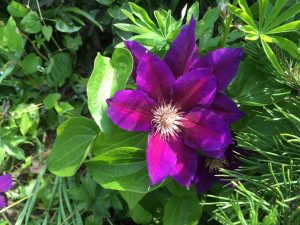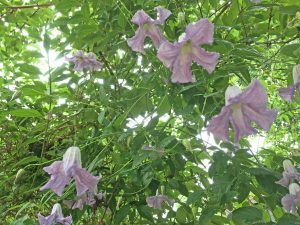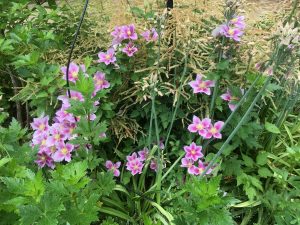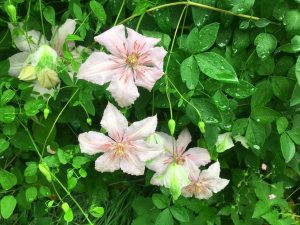
Clematis ‘Reiman’
Last weekend, when my garden was part of the Glorious Gardens of Shaker Heights tour, the two most asked questions by visitors were related to the identification of two clematis they had never seen before. Many people do not realize that not all clematis are large, open flowers. The two that needed identification were the bell type.

Clematis ‘Rooguchi’
What they saw, walking up the front driveway, was Clematis ‘Rooguchi’ twined through Rosa rugosa ‘Coeur d’Alène’ and Amorpha canescens. This lovely dark purple belled clematis has been in my garden since 2008 and it stops people in their tracks every time.

Clematis ‘Betty Corning’
Clematis ‘Betty Corning’ was the other bell-like clematis that no one recognized. She may be a Clematis viticella hybrid or cultivar. Her bells are larger, more open, and a pale pinky-lavender. I love all clematis but the species viticella has two special virtues: it never gets clematis wilt and it blooms nonstop from mid-June to fall.

Clematis viticella ‘Venosa Violacea’
My favorite viticella is ‘Venosa Violacea’, a purple and white bicolor that climbs up some wires on the garage wall and then across to act as a valance to the hayrack. She also manages to send some shoots into hayrack planting.
Visitors frequently commented on the fact that I have clematis growing everywhere, not just on trellises – up into conifers, sprawling on the ground and on hillsides, on obelisks set into groups of perennials into which they can then twine – but wherever I think they can display their beauty.

Clematis ‘Sapphire Indigo’
One of the newer sprawlers is ‘Sapphire Indigo’ that was given to me for trialing by Rusty Storrer from Monrovia. I have two, each starting on a short obelisk. They both survived the winter and are sharng their medium-sized, purple flowers with their neighbors.

Clematis ‘Piilu’
I wouldn’t want you to think that I only like the purple clematis. ‘Piilu’, with a bit of help, is climbing up a pole that holds a hanging basket but she has also attached herself to my Aconitum. She is a semi-double pale pink with dark pink bars.

Clematis ‘Huvi’, Lychnis ‘Firefly’

Clematis ‘Huvi’
‘Huvi’ is bright magenta and, with the help of another obelisk, is climbing into my Amsonia ‘Halfway to Arkansas’. For a few years, I had some color echo going there with Lychnis ‘Firefly’ but sadly, Lychnis don’t seem to like my garden.

Clematis ‘Niobe’ surrounded by Fallopia japonica ‘Variegata’

Clematis ‘Marmori’
‘Niobe’ is ruby red and scrambles up an old wrought iron fence section. ‘Marmori’ is pale pink and uses the canes of Rosa ‘John Cabot’ as her support.
Don’t be afraid to plant clematis because you don’t know to prune them. They will “talk” to you. In the Spring, examine the vines and see where there is foliation and where there isn’t. Just prune off what hasn’t foliated unless you need to use it as a support for the new growth. Everyone needs some clematis in the garden. Once you have one, and it will be hard to choose just one, you will probably find that you “need” more.


0 Comments